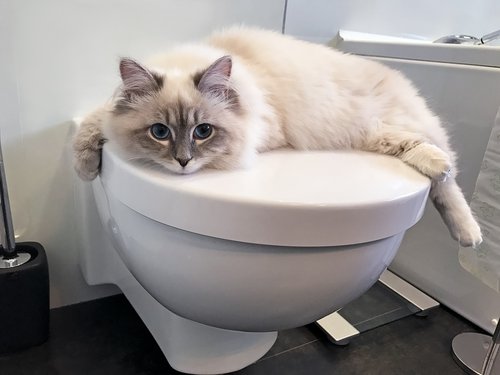
One of the most common cat behaviour issues with our resident felines is that they’re not always using their litter tray.
But can you fix this problem? The answer is a resounding yes.
With a litter bit of investigation (see what we did there?), this problem is shockingly easy to solve.
Why is my cat not using their tray?
There are four common reasons why a cat won’t use their tray. These are a preference to a surface or a location, OR an aversion to a surface or a location.
Each of these four categories has very specific reasoning and it can take a bit of sleuthing to find out which one your cat falls into:

Thank you Dr Karen Overall and diagnostic categories for this insight
Before undertaking any changes, it’s the ‘gold standard’ to pop along to your vets for a check-up.
A vet can check your cat for urinary tract issues or any stress or related health problems e.g., Hypothyroidism which can help to get to the bottom (no pun intended) of why they’re not using their tray.
While you wait for diagnostic test results, there are some things you can start work on.
Here are the top five things I recommend.
1. Get the RIGHT type of litter trays
Unfortunately, mass produced cat trays are marketed to the people that buy them, not the cat that will be using them.
These trays are too small, often covered over and some are ‘self-cleaning’, meaning that dirty litter is scooped into the bottom of the tray and covered over.
These trays are not made with your cat in mind.
Cats can’t stretch out in them and only one exit means your cat feels trapped. Cats need to know that they can escape from predators at any time. It’s instinctual.
As for a soiled toilet. Even if buried under something, I can guarantee your cat can smell it!
2. Clean your trays DAILY
Cats aren’t like dogs; they need a clean environment to go in and they don’t like a stinky toilet (does anyone?).
Cats need to be able to toilet multiple times a day in a clean tray. This means you should have several trays throughout your home and scoop the trays daily to remove waste.
A handy tip is to pop dog poo bags into a toilet bin nearby and have a scoop next to the tray. This way you can clean up daily without any fuss.
**3. Have multiple trays in the house **
If you’re unsure how many trays you need as a cat owner, this simple equation will help.
***Number of cats + 1 = number of trays in the house. ***
e.g., 1 cat = 2 trays, 2 cats = 3 trays etc.
This means that if one of the trays is dirty, another can easily be used. If one is occupied by ‘Fluffy’, then ‘Tommy’ can use another.
HOT TIP: Multiple trays shouldn’t be in the SAME ROOM when you have multiple cats in the house. Territorial aggression and guarding of the tray area by a cat can limit another cat’s access to it.
4. Keep toilets away from food areas and out of hot zones
Keep trays in quiet, low traffic areas in your home, separate from eating areas.
No one likes to sit near the toilet when eating or use a toilet that’s in the busiest part of the house. Why would your cat be any different?
5. Test your cat’s litter preference
When addressing surface preference, it’s best to line up your trays (only for this experiment mind you, then refer to #4) to test which one your cat uses first.
I prefer Clumping Clay as it feels soft, sandy, and silky and is the easiest for cleaning. There are also recycled paper and other softer litter options which your cat may prefer.
I would generally stay away from the crystal litters. If you’ve ever stepped on one of those crystals, it’s like stepping on an oyster shell!
A happy cat will scratch at their tray (seemly for HOURS!) and will cover up their #2! Cats generally love loads of litter so make sure you fill those trays up - don’t be stingy!
**Consult experience **
I once went to a consult to help a cat owner whose furry friend had never once used the tray.
I could see the cat’s tray only had a smattering of litter in the bottom, so I filled it up. The cat heard the sound, came barrelling out of the garden into the house and IMMEDIATELY went to the toilet in the tray. I could almost hear the cat’s sigh of relief “Phew, finally, I can use my toilet!"
Final advice
If you’re still struggling with toileting outside of their tray, and you’ve implemented ALL the changes that we’ve suggested above, then it’s possible that your cat’s problem is not a toileting one, but a stress one.
Some cats will require medication to help with anxiety, so speak to your Vet or a Vet Behaviourist to help you solve this problem and you could be solving the toileting along with it.